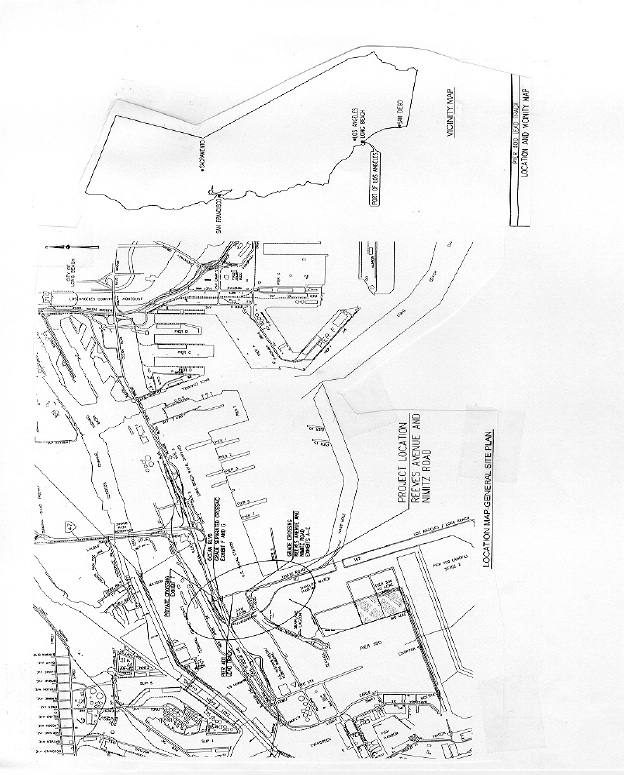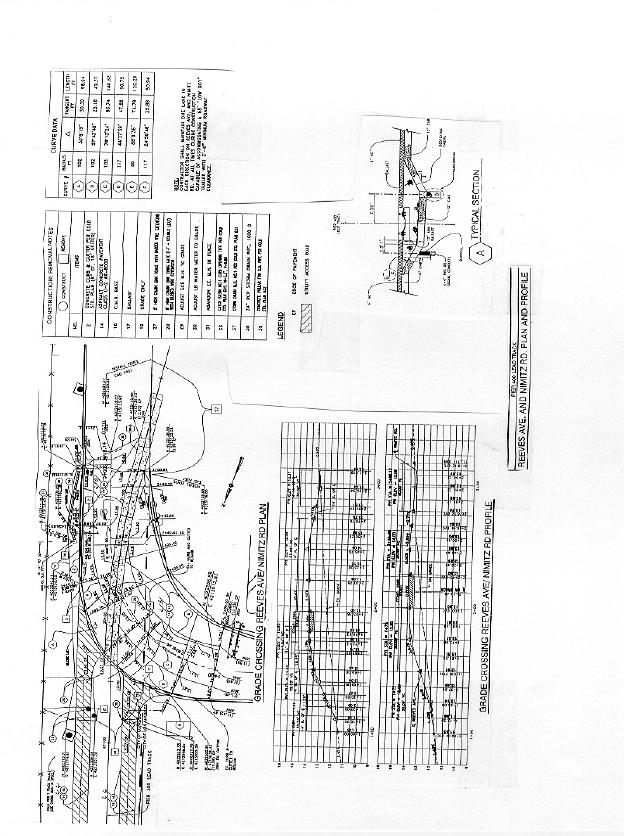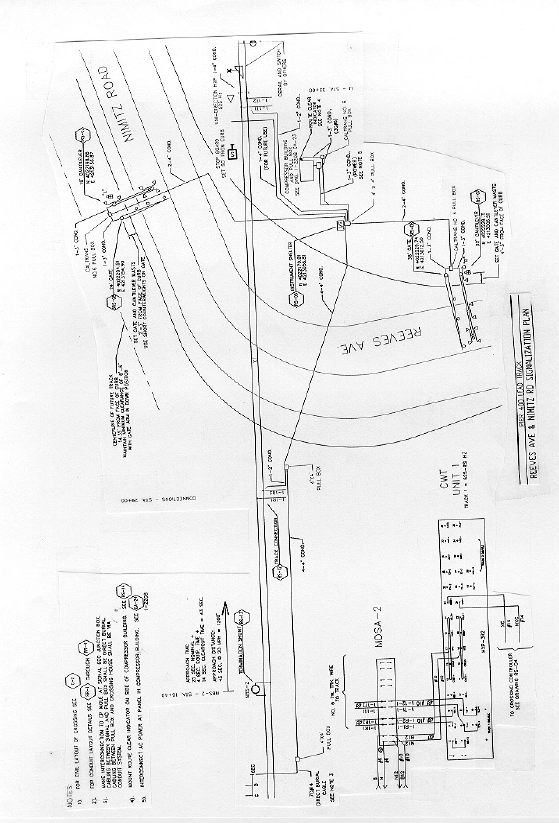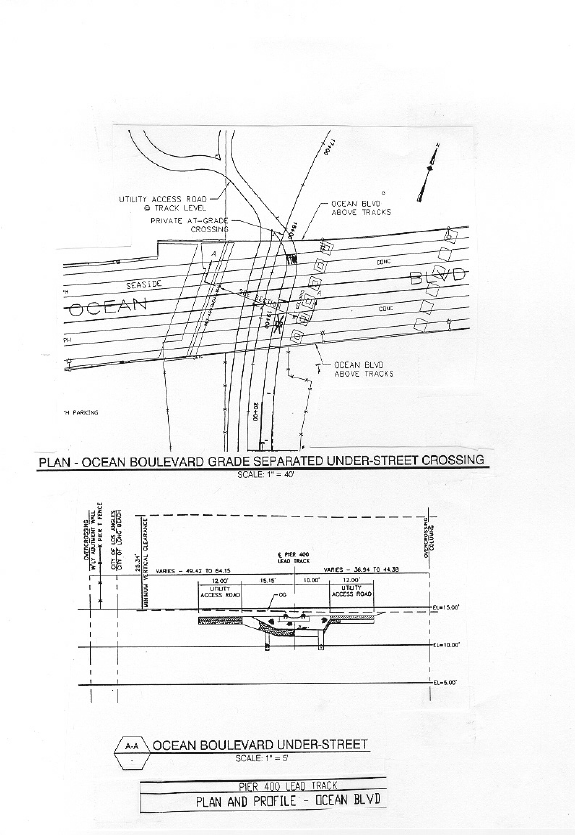Discussion
Harbor Department proposes to construct Ocean Boulevard overcrossing at separated grades and Reeves Avenue at-grade crossing as part of a project to construct a single lead track. The lead track will provide rail access off the existing Terminal Island main line to an intermodal container transfer facility to be constructed as a part of the proposed Pier 400 container terminal located off the south side of Terminal Island within the Port of Los Angeles. The site is accessible by BNSF, PHL, and UP from the south end of the Alameda Corridor by means of the Badger Avenue Railroad Bridge crossing to Terminal Island.
The project site is located at the southern end of the City of Los Angeles, in the Port of Los Angeles. The Port of Los Angeles is an area primarily used for commercial shipping and industrial and maritime activities. Facilities present include major bulk liquid handling and storage facilities, container terminals, cargo terminals, fish canneries, auto storage and handling facilities, a sewage treatment plant, fire stations, and the following federal facilities: the United States (U.S.) Coast Guard Station; the U.S. Customs Building; and federal immigration, quarantine, and penal facilities.
Harbor Department is the lead agency for this project under the California Environmental Quality Act of 1970 (CEQA, as amended in 1982), as stated in Public Resources Code Section 21000, et seq. Harbor Department included the proposed grade separation overcrossing of Ocean Boulevard and the proposed at-grade crossing of Reeves Avenue in the Supplemental Environmental Impact Report (SEIR) for the Pier 400 Container Terminal and Transportation Corridor Project. The SEIR, which was assigned State Clearinghouse (SCH) No. 98031135, was approved on October 5, 1999, and has been certified by City of Los Angeles Board of Harbor Commissioners (Board of Harbor Commissioners).
On November 15, 1999, Harbor Department filed a Notice of Determination with the State of California - The Resources Agency, Los Angeles County Clerk, and Los Angeles City Clerk, which found that the "project will have a significant impact on the environment." Mitigation measures were made a condition of project approval. A Statement of Overriding Considerations (SOC) was adopted for the project. A copy of this Notice is included in Appendix A attached to this order.
The Commission is a responsible agency for this project under CEQA (Public Resources (PR) Code Section 21000 et seq.) and has independently reviewed, assessed, and considered the lead agency's SEIR. CEQA requires that the Commission consider the environmental consequences of a project that is subject to its discretionary approval. In particular, to comply with CEQA, a responsible agency must consider the lead agency's Environmental Impact Report (EIR) or Negative Declaration prior to acting upon or approving the project (CEQA Guideline 15050(b)). The specific activities, which must be conducted by a responsible agency, are contained in CEQA Guideline Section 15096.
The Commission has reviewed the lead agency's environmental documents for the Pier 400 Container Terminal and Transportation Corridor Project (SCH No. 98031135), and we find these documents adequate for our decision-making purposes. In considering this documentation, we note that the EIR developed and evaluated a range of alternatives as well as a No Project Alternative. The SEIR included an analysis of potential environmental impacts related to the project and alternatives related to meteorology and air quality, ground transportation, biota and habitats, and noise and vibration. Safety, security, transportation and noise are within the scope of the Commission's permitting process.
The Commission also notes that construction of the Pier 400 landfill was assessed under the Deep Draft Navigation Improvements Program EIS/EIR (Environmental Impact Statement/Environmental Impact Report) prepared by U.S. Army Corps of Engineers - Los Angeles District and Harbor Department. The Deep Draft EIS/EIR assessed impacts resulting from the dredging of ship channels and the placements of dredged materials to create the Pier 400 landfill. The Deep Draft EIS/EIR addressed, at a programmatic level, the construction of a container terminal and dry bulk export terminal on Pier 300 and the construction of terminals, including a container terminal, on Pier 400. Terminal developments were left for detailed assessment as development projects arose. Both proposed projects on Pier 300 have been assessed at a project level by subsequent project specific EIRs. Harbor Department has constructed and has placed into operation the container terminal on Pier 300. Harbor Department has constructed and has placed into operation the first phase of the Pier 300 dry bulk terminal.
The SEIR presented is for the Pier 400 Container Terminal and Transportation Corridor Project. The Mitigation Monitoring and Reporting Program (MMRP) adopted by the lead agency identified environmental impacts related to ground transportation and noise and vibration.
The proposed project, identified in the SEIR as "Alternative Design with Filled Gap," is the two-phase development of Pier 400 Stage II into a 510-acre container terminal with full rail, highway, and utilities access.
Phase 1B of the Pier 400 Container Terminal and Transportation Corridor Project includes the following items:
· The construction of rail and highway access leading to and on the transportation causeway, constructed as part of the Pier 400 Stage I Dredging and Landfill Project; and
· The construction of 340 acres of the Pier 400 Stage I and II landfill into a fully operational, container terminal. This includes a 20-acre full gate complex with buildings, entrance gate complex, and parking; a five post-Panamax berth wharf (5,300 feet long) with 100 feet gage crane rails; and intermodal rail capabilities including a minimum of eight working tracks (100-foot to 305-foot car capacity) and rail storage tracks (dedicated inbound and outbound tracks on the corridor).
Phase 2B of the Pier 400 Container Terminal and Transportation Corridor Project includes the following item:
· The construction of the remaining 170 acres of the Pier 400 Stage II landfill will make up a 510-acre, fully operational, container terminal. Construction will include approximately 3,000 linear feet of additional berthing, and marine and longshore toilet buildings. The completed facility will include an eight post-Panamax berth wharf (8,300 feet long) with 100 feet gage crane rails, a four-unit train loading yard with a minimum of eight working tracks (100-foot to 305-foot car capacity), rail storage tracks (dedicated inbound and outbound tracks on the corridor), and multiple buildings to support terminal operations.
The proposed project includes "Gap Closure" using a fill. The Pier 400 Transportation Corridor was constructed with a 350-foot wide gap in it. Harbor Department is to refine issues related to appropriate design for the Pier 400 Transportation Corridor during the Final Design and permitting phase of the Deep Draft Navigation Improvements Project. Due to time constraints, Harbor Department opted to include the gap in the Pier 400 Transportation Corridor in lieu of conducting additional water quality modeling to further characterize effects on water quality and indirectly on biota in these areas. Gap closure alternatives originally considered including filling or bridging. Impacts from bridge or fill options differ as do the mitigation measures available. Filling the gap is now the preferred option as long as all permitting requirements can be met within a reasonable time period.
Harbor Department identified one significant and unavoidable ground transportation impact. For each of the four mitigation measures below, the significance after mitigation is significant. A potentially significant adverse impact (increased traffic during operation of the proposed terminal that could significantly impact project intersections and Interstate (I) 710 (Long Beach Freeway)) is to be mitigated as follows:
· Construct a ramp to accommodate westbound-to-southbound left turns at Seaside Avenue and Navy Way intersection.
· Construct a grade separation at Navy Way and Terminal Way intersection to accommodate for the inbound Pier 400 access road.
· Construct a diamond interchange (or equivalent improvement) at Ocean Boulevard and State Route (SR) 47 (Terminal Island Freeway) intersection.
· Construct a grade separation at Alameda Street and SR 1 (Pacific Coast Highway) intersection.
For the first mitigation measure (Seaside Avenue Ramp), to comply with the monitoring and reporting requirement, Harbor Department Construction Manager shall submit the appropriate Mitigation Monitoring Report form, prior to construction, to Harbor Department Environmental Management Division. Execution of the form acknowledges that Seaside Avenue Ramp is included in the specifications for the project. The "Person Completing Form" shall be Harbor Department Construction Manager. The "Responsible Person" shall be Chief Harbor Engineer.
For the second mitigation measure (Terminal Way Grade Separation), to comply with the monitoring and reporting requirement, Harbor Department Construction Manager shall submit the appropriate Mitigation Monitoring Report form, prior to construction, to Harbor Department Environmental Management Division. Execution of the form acknowledges that Terminal Way Grade Separation is included in the specifications for the project. The "Person Completing Form" shall be Harbor Department Construction Manager. The "Responsible Person" shall be Chief Harbor Engineer.
For the third mitigation measure (Ocean Boulevard and Terminal Island Freeway Improvements), there is no monitoring and reporting requirement since the project is funded and approved. The project is the responsibility of the Port of Long Beach and State of California Department of Transportation (Caltrans).
For the fourth mitigation measure (Alameda Street Grade Separation), there is no monitoring and reporting requirement since the project is funded and approved. The project is the responsibility of Alameda Corridor Transportation Authority.
Harbor Department identified two significant and unavoidable noise and vibration impacts. A potentially significant adverse impact of increased truck traffic noise on the grounds outside and classrooms inside the Naval and Marine Corps Reserve Center (NMCRC) would exceed appropriate speech interference thresholds during Phases 1B and 2B. There is no feasible mitigation measure for this impact and no monitoring and reporting requirement. The significance after mitigation is significant for Phases 1B and 2B.
A potentially significant adverse impact of train horns sounded adjacent to the NMCRC would cause a potentially significant noise impact during Phases 1B and 2B is to be mitigated as follows: Eliminate the at-grade crossing at Reeves Avenue, or eliminate train horns adjacent to the NMCRC, or construct a 16-foot to 20-foot high sound wall adjacent to the NMCRC along the railroad alignment. Measures that would eliminate the need for train horns are preferable for either the one-track or two-track scenario. The significance after mitigation is insignificant. This impact and its associated mitigation measure would only apply to the first alternative rail corridor, the Navy Mole Overhead Rail Alignment. Selection and use of the second alternative rail corridor, the Navy Way Overhead Rail Alignment, avoids this impact.
Under MMRP, Harbor Department is responsible for monitoring and reporting the implementation of the mitigation measures.
The Commission also has reviewed the lead agency's "SYNOPSIS OF MINUTES OF THE SPECIAL MEETING OF THE LOS ANGELES BOARD OF HARBOR COMMISSIONERS" of "TUESDAY, OCTOBER 5, 1999," et al. The Board of Harbor Commissioners' documents declared the intent to:
1. Certify that the SEIR for the Pier 400 Container Terminal and Transportation Corridor Project has been reviewed, considered, and determined to have been completed in compliance with CEQA of 1970 as amended, State CEQA Guidelines, and Los Angeles City CEQA Guidelines; and that all procedures have been completed.
2. Adopt the findings of the Board of Harbor Commissioners that, in accordance with the information contained in the SEIR for the Pier 400 Container Terminal and Transportation Corridor Project, the project identified in the SEIR as "Alternative Design with Filled Gap" will have a potentially significant effect upon the environment in the areas of meteorology and air quality, ground transportation, biota and habitats, and noise and vibration as defined by Los Angeles City CEQA Guidelines Article II, Section 36 and Article IV, Section 3.
3. Adopt the findings of the Board of Harbor Commissioners that, in accordance with the provisions of Los Angeles City CEQA Guidelines Article VI, Section 9.5 and State CEQA Guidelines Section 15091, changes or alterations have been required in, or incorporated into, the proposed project, which mitigates, where mitigation is required, or avoids the adverse environmental impacts identified in the SEIR. Not all significant impacts can be totally mitigated.
4. Adopt the findings of the Board of Harbor Commissioners that, in accordance with State CEQA Guidelines Section 15093, the benefits of the project outweigh the potentially significant environmental impacts of the project. Adopt the Findings of Fact and SOC.
5. Adopt the findings of the Board of Harbor Commissioners that the MMRP fulfills the environmental protection intent of PR Code Section 21081.6, and fulfills the responsibilities of the Harbor Department, as lead agency, to monitor and verify project compliance with those conditions of project approval for the purpose of mitigating significant environmental impacts. Adopt the MMRP as required by PR Code Section 21081.6.
6. In consideration of the SEIR, Findings of Fact, and SOC, determine to carry out the project identified in the SEIR as "Alternative Design with Filled Gap," including the conditions set forth in the EIR, the Statements of Findings and Overriding Considerations, and the MMRP where they are within the jurisdiction of the Board of Harbor Commissioners.
7. Direct Harbor Department Engineering Division to incorporate the mitigation measures, conditions, and mitigation monitoring and reporting plan into all engineering plans and specifications and all engineering permits for the proposed project.
8. File a Notice of Determination for the subject project with Los Angeles County Clerk, Los Angeles City Clerk, and State Secretary of Resources.
The Board of Harbor Commissioners adopted the SOC with respect to significant and unavoidable adverse environmental impacts identified in the SEIR related to four specified meteorology and air quality impacts, one ground transportation impact, five biota and habitats impacts, and two noise and vibration impacts and the cumulative impacts of the project when combined with other projects in the vicinity. In adopting the SOC, the Board of Harbor Commissioners noted several benefits from the proposed project, including the following benefits:
1. The proposed project is one of several developments within Port of Los Angeles complex to optimize existing facilities and accommodate cargo throughput needs. The proposed project would preclude the need to develop facilities in other coastal areas. The project will result in locally significant environmental impacts, while minimizing the impacts to the marine environment of the southern California region and maintaining and enhancing the long-term economic and environmental productivity of the region.
2. The Tideland Trust Act of 1911 mandates that City of Los Angeles promotes and develops maritime-related commerce, navigation, and fisheries. The proposed project assists City of Los Angeles in promoting and developing maritime-related commerce by accommodating the documented demand for additional container terminals. Therefore, the project is economically beneficial to the state.
3. The proposed project implements elements of the Deep Draft Navigation Improvements (2020 Plan) which have the following benefits:
a. "National Economic Benefits" as discussed and determined in the U.S. Army Corps of Engineers' Feasibility Reports for the Deep Draft Navigation Improvements.
b. Over 12,000 jobs would be associated with implementation of the 2020 Plan if both construction and nonconstruction jobs are included.
c. Construction expenditures in the Port estimated at over $2 billion with associated generation of substantial sales and use taxes to local, state, and federal jurisdictions.
d. Over 71,000 port-related jobs would be associated with developments through the year 2020 and 339,000 jobs would be created if non-port jobs are included.
e. Result in the creation and restoration of a shallow coastal embayment habitat associated with coastal wetlands that provide incidental benefits to the state and nation that exceed their value as mitigation for marine resource losses. These items include benefits to endangered species that do not exist in the harbor, expansion of vegetated wetlands, flood control, passive recreation and aesthetic values, a migratory bird habitat (e.g. special aquatic sites such as mud flats) and educational benefits.
f. Result in air quality benefits to the region through efficiencies achieved in cargo handling. These efficiencies include the following items: use of fewer and larger vessels to serve new facilities; avoidance of vessel queuing and associated emissions due to availability of additional berths; adequate area adjacent to the berth for efficient cargo movement with a minimum of double handling; and implementation of near-dock rail facilities to divert cargo from truck to rail. The latter efficiency implements a Tier 2 measure (Measure 3.6) of the South Coast Air Quality Management District's Air Quality Management Plan.
g. Minimize conflicts associated with further Port expansion into adjacent communities by providing land for new industrial facilities on and seaward of Terminal Island.
Board of Harbor Commissions found that the benefits of the proposed project outweigh the unavoidable significant adverse environmental impacts and specifically stated that each of the separate benefits identified in its document was determined to be, in itself and independent of other project benefits, a basis for overriding all unavoidable impacts identified in the SEIR. We find that none of the unavoidable significant adverse environmental impacts can be attributed to the proposed overcrossing at separated grades of Ocean Boulevard and the proposed at-grade crossing of Reeves Avenue.
In reviewing the SEIR, we find that with respect to issues within the scope of our permitting process, feasible mitigation measures were adopted when possible, to lessen the significant environmental impacts to less-than-significant levels. We will adopt Harbor Department findings and mitigations for purposes of our approval.
With respect to the SOC, we find that Board of Harbor Commissioners enumerated several significant benefits associated with the proposed project which appeared, on balance, to reasonably override the unavoidable impacts. Therefore, we accept and adopt the findings of the SOC for purposes of our approval.
The sites of the proposed overcrossing at separated grades of Ocean Boulevard and the proposed at-grade crossing of Reeves Avenue have been inspected by the Commission's Consumer Protection and Safety Division - Rail Crossings Engineering Section staff. After reviewing the need for and the safety of the proposed overcrossing at separated grades of Ocean Boulevard and the proposed at-grade crossing of Reeves Avenue, staff recommends that the Harbor Department's request be granted. Reeves Avenue will be at grade since minimal roadway traffic on Reeves Avenue and significant impacts to the U.S. Naval Station and adjacent properties and industries make the separation of grades of Reeves Avenue not practicable. The at-grade crossing of Reeves Avenue is necessary to connect, by way of Nimitz Road, the U.S. Naval Station, the Navy Mole, and Piers 15 and 16 with Ocean Boulevard, the Gerald Desmond and Commodore Helm Bridges, and the U.S. Customs House/Federal Building.
The Application is in compliance under the Commission's filing requirements, including Rule 40 of Rules of Practice and Procedure, which relates to the construction of a railroad track across a public highway. A site map and detailed drawings of the proposed overcrossing at separated grades of Ocean Boulevard and the proposed at-grade crossing of Reeves Avenue are shown in Appendix B attached to the order.
In Resolution ALJ 176-3076, dated November 29, 2001, and published in the Commission Daily Calendar on November 30, 2001, the Commission preliminarily categorized this application as ratesetting, and preliminarily determined that hearings were not necessary. Since no hearings were held, this preliminary determination remains accurate. The Commission's Consumer Protection and Safety Division recommends that this application be granted. Given these developments, a public hearing is not necessary, and it is not necessary to disturb the preliminary determinations made in Resolution ALJ 176-3076.
This is an uncontested matter in which the decision grants the relief requested. Accordingly, pursuant to Public Utilities Code Section 311(g)(2), the otherwise applicable 30-day period for public review and comment is being waived.
Assignment of Proceeding
Richard Clark is the assigned Examiner in this proceeding.
Findings of Fact
1. Notice of the Application was published in the Commission Daily Calendar on November 20, 2001. There are no unresolved matters or protests; a public hearing is not necessary.
2. Harbor Department requests authority, under Public Utilities Code Sections 1201-1205, to construct a grade-separated overcrossing of Ocean Boulevard through City of Long Beach right-of-way and an at-grade crossing of Reeves Avenue through City of Long Beach and City of Los Angeles right-of-way, both located near the center of Terminal Island over Harbor Department's tracks in Cities of Long Beach and Los Angeles, Los Angeles County. BNSF and UP are anticipated to operate trains at the sites of the proposed crossings. PHL provides railroad switching, dispatching and maintenance services within the vicinity of Ports of Los Angeles and Long Beach.
3. Construction of the proposed overcrossing at separated grades of Ocean Boulevard and the proposed at-grade crossing of Reeves Avenue are necessary as part of the construction of a single lead track that will provide rail access off the existing Terminal Island mainline to an intermodal container transfer facility. The intermodal container transfer facility will be constructed as a part of the proposed Pier 400 container terminal located off the south side of Terminal Island within the Port of Los Angeles.
4. Public convenience, necessity, and safety require construction of the proposed overcrossing at separated grades of Ocean Boulevard.
5. Public convenience and necessity require construction of the proposed at-grade crossing of Reeves Avenue. Reeves Avenue will be at grade since minimal roadway traffic on Reeves Avenue and significant impacts to the U.S. Naval Station and adjacent properties and industries make the separation of grades of Reeves Avenue not practical. The at-grade crossing of Reeves Avenue is necessary to connect, by way of Nimitz Road, the U.S. Naval Station, the Navy Mole, and Piers 15 and 16 with Ocean Boulevard, the Gerald Desmond and Commodore Helm Bridges, and the U.S. Customs House/Federal Building.
6. Public safety requires that warning devices at the proposed at-grade crossing of Reeves Avenue be two Standard No. 9-A automatic gate-type signals with additional flashing lights on cantilever arms, as specified in General Order 75-C.
7. Harbor Department is the lead agency for this project under CEQA, as amended.
8. In approving the project on October 5, 1999, Board of Harbor Commissioners certified the SEIR for the Pier 400 Container Terminal and Transportation Corridor (SCH No. 98031135) of which the proposed overcrossing at separated grades of Ocean Boulevard and proposed at-grade crossing of Reeves Avenue are included. Board of Harbor Commissioners adopted an SOC in approving the project.
9. The Commission is a responsible agency for this project, and has reviewed the lead agency's SEIR, Notice of Determination, and SOC. We find these documents adequate for our decision-making purposes.
10. Ground transportation and noise and vibration are within the scope of the Commission's permitting process.
Conclusions of Law
1. With respect to significant impacts within the Commission's permitting authority, we find that the lead agency adopted feasible mitigation measures where possible to substantially lessen the impacts to a less-than-significant level. As stated herein, we also accept and adopt the findings in the SOC for purposes of our approval.
2. The application should be granted as set forth in the following order.
ORDER
IT IS ORDERED that:
1. City of Los Angeles Harbor Department (Harbor Department) is authorized to construct an overcrossing at separated grades at Ocean Boulevard and an at-grade crossing at Reeves Avenue over a proposed single lead track owned by Harbor Department in the Cities of Long Beach and Los Angeles, Los Angeles County, at the location and substantially as shown by the plans attached to the Application and Appendix B of this order, identified as PUC Crossing Numbers A-19.30-A (Ocean Boulevard grade separation overcrossing) and A-19.45 (Reeves Avenue at-grade crossing).
2. Clearances shall be in accordance with General Order (GO) 26-D.
3. Construction of the Reeves Avenue at-grade crossing shall be in accordance with GO 72-B. Maintenance of the crossing surfaces shall also be in accordance with GO 72-B.
4. Harbor Department shall install at the Reeves Avenue at-grade crossing two Standard No. 9-A automatic gate-type signals with additional flashing lights on cantilever arms warning devices, as specified in GO 75-C.
5. Walkways shall conform to GO 118. Walkways adjacent to any trackage subject to rail operations shall be maintained free of obstructions and shall be promptly restored to their original conditions in the event of damage during construction.
6. Construction expense of the crossings and installation cost of the automatic warning devices at Reeves Avenue at-grade crossing shall be borne by Harbor Department.
7. Maintenance cost of the automatic warning devices at Reeves Avenue at-grade crossing shall also be borne by Harbor Department.
8. Construction plans of the crossings, approved by The Burlington Northern and Santa Fe Railway Company, Pacific Harbor Lines, and Union Pacific Railroad Company, together with a copy of the agreement entered into between the parties, shall be filed with the Commission's Consumer Protection and Safety Division prior to commencing construction.
9. Within 30 days after completion of the work under this order, Harbor Department shall notify the Commission's Consumer Protection and Safety Division staff in writing, by submitting a completed standard Commission Form G (Report of Changes at Highway Grade Crossings and Separations), that the authorized work was completed.
10. This authorization shall expire if not exercised within three years unless time is extended or if the above conditions are not complied with. Authorization may be revoked or modified if public convenience, necessity or safety so require.
11. The application is granted as set forth above.
12. Application 01-11-021 is closed.
This order becomes effective 30 days from today.
Dated , at San Francisco, California.
A P P E N D I X A
ENVIRONMENTAL DOCUMENT
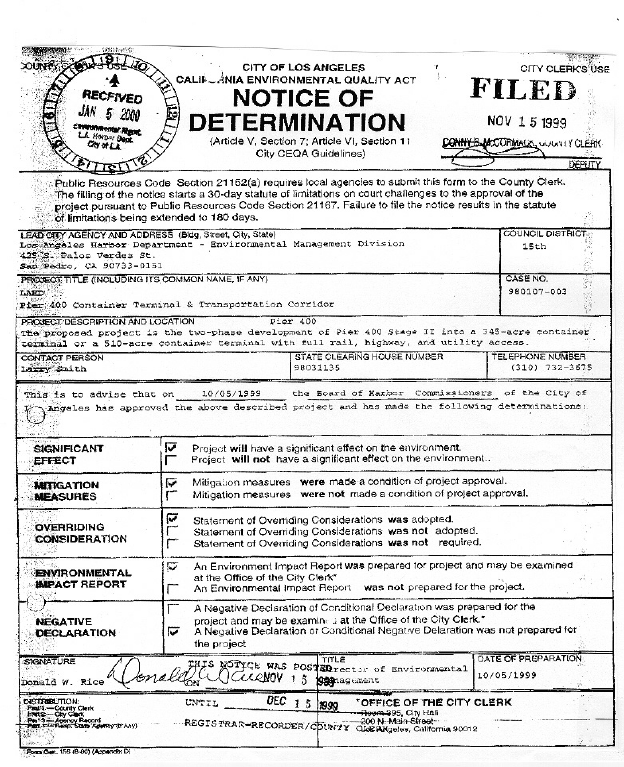
A P P E N D I X B
PLANS
